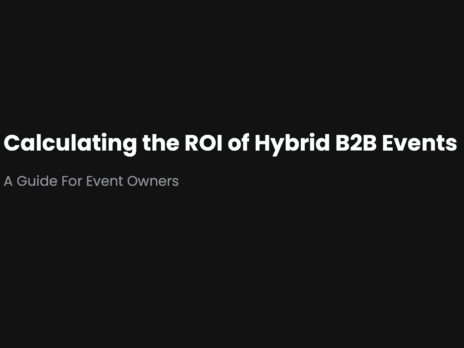
The role of in-person interactions in B2B sales and marketing is shifting. Sponsorship that is sold on the number of potential handshakes in the room may no longer be enough. The evidence shows that buyers expect more digital touchpoints when engaging with potential suppliers. This will totally reframe how B2B organisations evaluate event sponsorship.
The winners will be those event organisers that can support a sponsor’s own omnichannel sales strategy, providing new digital inventory to supplement the live experience.
The mass adoption of virtual events allowed organisers to rise to this challenge, giving them more insight than they’d ever had before on their audience. The challenge now? In-person events are back with gusto. Event revenues have recovered since the return to in-person, which weakens the case for investing in the complexity of hybrid or an elevated virtual offering.
Yet the ground is shifting. Publishers must develop a strategy that both capitalises on the resurgence of in-person while recognising that their sponsors will soon be yearning for something more. The time to experiment with hybrid is now.
The rise of the digitally dominant buyer
Last year, an article in the Harvard Business Review made the claim that traditional B2B sales and marketing models were already becoming obsolete. “Today’s buyers are not only channel agnostic in terms of behaviour,” the author, Brent Adamson, observed, “they’re digitally dominant in terms of preference.”
And the number of channels used by B2B buyers to learn about solutions has increased significantly in recent years. By 2025, 80% of all B2B buyer interactions will occur in digital channels, according to Gartner. Concerningly for event organisers, trade shows are no longer one of the top ten channels used by B2B decision-makers to interact with suppliers. This is a wake-up call to publishers that believe their revenue models that are entirely reliant on in-person events are untouchable.
The evidence suggests that no matter the industry or geography, all B2B organisations will spend more time engaging with their target customers digitally. The reality check for event sponsorship is coming. Sponsors are already investing in new ways to influence customers online and traditional conceptions about B2B sales and marketing are being totally transformed.
Gartner’s survey of 750 B2B buyers involved in buying decisions for complex solutions reports that customers spend just 17% of their time interacting with sales teams. This compares with a quarter of their time (27%) completing independent learning online.
Even more concerning for leaders is the time spent interacting with sales teams is split between all suppliers, meaning B2B sales teams have a vanishingly small window of opportunity to interact with that customer. This may have huge ramifications for conferences and exhibitions. Event organisers that only seek to monetise in-person interactions are chasing a decreasing piece of their sponsors’ sales funnel.
Publishers must rethink what event sponsorship offers
Monetising access to buyers has been central to B2B publishers’ business model. Of course, as real-life customer interactions become more challenging for organisations, they may place a premium on these opportunities. Harvard Business Review states that the small window of direct interaction is the single biggest challenge for B2B sales teams today. This scarcity bodes well for publishers to sustain their in-person events. However, it leaves them vulnerable to the rise of competitors with digital communities and a hybrid offering that serves a wider spectrum of needs.
Customers spend one-quarter of their time learning about solutions online. Innovative event design can provide new content inventory and engagement opportunities that let sponsors influence customers when they’re in this zone.
For example, take sponsor branding on the event website. A sponsor profile with video, downloads, lead capture, team profiles, thought leadership articles, podcasts and meeting scheduler is what a digitally dominant buyer will prefer. They are already consuming this in their research, it’s just not provided on the event website.
Another approach is to programme event content to have value beyond the day of the event. Repurposing full sessions into insightful clips or specific questions or slides generates digital media that can be consumed by audiences at their convenience.
Publishers are well positioned to jump on these revenue opportunities. Their understanding of the value of content gives them an advantage in building solutions that grab and hold audiences’ attention. What new inventory will drive outcomes for a sponsor that’s looking to boost their digital customer engagement? Well, that’s likely to be different for each industry, but publishers can afford to be bold in testing new ideas with their market.

Calculating the ROI of hybrid
Resurgent demand for in-person has made many of the learnings from the virtual pivot a distant memory. Yet the experience has prepared the industry to mount a successful response.
Hybrid events, traditionally perceived as an in-person conference that is simultaneously broadcast online, has failed to go mainstream given the complexity and cost of meeting distinct audience needs.
Yet publishers are limiting their horizons by thinking of hybrid as this single definition. Hybrid events are coming in more than one shape or size. Lydia Imirtziadis of EI Agency highlighted some very exciting examples emerging of what the future holds for hybrid event design.
Those that are prepared to experiment will gather audience data ahead of the competition and build deeper insights that will allow them to respond to digital opportunities with confidence. As hybrid events become more creative there will be different ways to model the return on investment:
- Cost of remote audience acquisition: additional cost of streaming divided by remote audience.
- Lead qualification: conversion rate of remote audience to future customer/attendee/subscriber/sponsor/member.
- Content marketing: attributing a value to engagement with digital content.
The digitally dominant buyer is here and they’re attending your conference. Are you meeting their needs?
Publishers must use their unique insight on audiences, learnings from virtual and understanding of content to find a new paradigm for event sponsorship. The winners will be able to supplement premium, in-person interactions with the digital channels that are becoming embedded in their audience’s purchasing decisions.
Email pged@pressgazette.co.uk to point out mistakes, provide story tips or send in a letter for publication on our "Letters Page" blog

